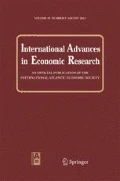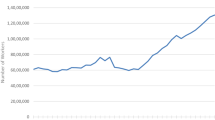Abstract
This paper examines the evolution of the National Industrial Recovery Act (NIRA) from its intellectual origins in the writings of Tugwell and Moulton, to the passage of the Act itself on June 17, 1933. What began as an attempt to address a structural problem, namely the widening gap between productivity and wages in manufacturing and mining, was transformed by President Franklin Roosevelt and Hugh Johnson into an economy-wide, multi-purpose policy instrument in the form of the NIRA and the subsequent President’s Reemployment Agreement (PRA). The multiple objectives and comprehensive breadth of the NIRA ultimately contributed to its demise. A simultaneous review of structural, cyclical and moral objectives, shows that the NIRA failed on all accounts. Specifically, firm and industry heterogeneity conspired to defeat all three objectives. Wages were increased in industries that had not been touched by electrification, contributing to lower aggregate employment and higher prices, thus providing an example of what not to do in the current debate over raising the minimum wage to $15.
Similar content being viewed by others
Notes
Besides the wage problem, Tugwell (1933) focused on a number of issues, including the challenges of vertical integration, especially the coordination problem, the role of skill in the serialization of production, and the role of competition, notably the theory of competition, in an era of rising concentration. The Industrial Discipline and the Governmental Arts should be seen as a critique of the second industrial revolution and its many challenges, organizational as well as macroeconomic.
This was also an integral part of the writings of Bellamy’s Progressives Movement, the Institutionalist Movement, and the Technocracy Movement.
One could argue that President Roosevelt’s interest in social justice had its origins in the Progressive Movement and one of its leaders, Theodore Roosevelt.
In fact, an additional dimension could be added, with firms that had adopted the new technology and experienced higher productivity, and those who had done so but who had not experienced higher productivity. This could be attributed to scale effects where productivity only rises if the firm operated at its new, higher technology.
In fact, Hugh Johnson defended the NIRA on the grounds that by fixing prices, the legislation helped smaller firms (firms that had not electrified), thus maintaining or even increasing competition.
As in Keynesian and Neo-Keynesian models, the demand side of the market is determinant.
This captures the Keynesian, non-market clearing aspect of the model as firms, owing to constraints in the product market, are forced to operate off of their labor demand curve.
The PRA, which was universal in scope, was used as a proxy fo the high wage provisions of the NIRA, specifically of the Codes of Fair Competition.
Sector 1 firms are operating off of their labor demand curves.
Employment in Sector 1 is not affected by the wage increase as firms are already off of their labor demand curve.
Taylor (2019) came to a similar conclusion, finding that its application was highly uneven across industries and sectors.
In a nutshell, the compliance crisis refers to the spring of 1934, when firms in general failed to comply with the conditions contained in the Codes of Fair Competition.
References
Alexander, B. (1997). Failed cooperation in heterogeneous industries under the National Recovery Administration. The Journal of Economic History, 57(2), 322–344.
Beaudreau, B.C. (1996). Mass production, the stock market crash, and the great depression: The macroeconomics of electrification. Westport: Greenwood Press.
Beaudreau, B.C. (2005). The national industrial recovery act redux: Technology and transitions. New York: iUniverse.
Beaudreau, B.C., & Taylor, J.E. (2018). Why did the Roosevelt administration think cartels, higher wages, and shorter workweeks would promote recovery from the great depression?. The Independent Review, A Journal of Political Economy, 23(1), 91–107.
Cole, H.L., & Ohanian, L.E. (1999). The Great Depression in the United States from a neoclassical perspective. Federal Reserve of Minneapolis Quarterly Review, 23 (1), 2–24.
Cole, H.L., & Ohanian, L.E. (2004). New deal policies and the persistence of the great depression. Journal of Political Economy, 112(3), 779–816.
Christoffel, K., Kuester, K., Linzert, T. (2006). Identifying the role of labor markets for monetary policy in an estimated DSGE model, European Central Bank, Working Paper Series, No. 635. (https://www.ecb.europa.eu/pub/pdf/scpwps/ecbwp635.pdf).
David, P. (1990). The dynamo and the computer: an historical perspective on the modern productivity paradox. American Economic Review Papers and Proceedings, 80(2), 355–361.
DeLong, J.B. (2009). The new deal: lessons for today: questions and answers. Prepared for the Economic Policy Subcommittee of the Senate Subcommittee on Banking, Housing and Urban Affairs, March 31. https://www.banking.senate.gov/imo/media/doc/DeLongtestimony33109.pdf.
Eggertsson, G.B. (2008). Great expectations and the end of the depression. American Economic Review, 98(4), 476–516.
Filene, E.A. (1924). The way out: A forecast of coming changes in American business and industry. New York: Doubleday, Page and Co.
Friedman, M., & Schwartz, A.J. (1963). A monetary history of the United States 1867-1960. New York: National Bureau of Economic Research.
Friedman, B.M. (2007). FDR and the depression: The big debate. New York Review of Books, November 8. (https://www.nybooks.com/articles/2007/11/08/fdr-the-depression-the-big-debate/).
Klein, L. (2004). The contribution of Jan Tinbergen to economic science. De Economist., 152(2), 155–167.
Moulton, H.G. (1935). Income and economic progress. Washington DC: The Brookings Institution.
New York Times. (1933). Ford Asserts Pay Must Be Increased, New York Times, June 16, 1933, p. 11.
Rauchway, E. (2008). The great depression and the New Deal. New York: Oxford University Press.
Shlaes, A. (2007). The forgotten man: A new history of the great depression. New York: Harper Collins.
Stabile, D. (2016). The political economy of a living wage: Progressive, the New Deal and social justice, in Palgrave studies in American economic history. New York: Springer Nature, Palgrave Macmillan.
Sumner, S.B. (2015). The Midas paradox: Financial markets, government policy shocks and the great depression. Oakland: Independent Institute, Independent Publishers Group.
Taylor, J., & Klein, P.G. (2008). An anatomy of a cartel: The National Industrial Recovery Act of 1933 and the compliance crisis of 1934. Research in Economic History, 26, 235–271.
Taylor, J. (2011). Work-sharing during the great depression: Did the President’s Reemployment Agreement Promote Reemployment? Economica, 78(1), 133–158.
Taylor, J. (2019). Deconstructing the monolith: The microeconomics of the national industrial recovery act. Chicago: University of Chicago Press.
Tinbergen, J. (1952). On the theory of economic policy. North Holland: Amsterdam.
Tugwell, R.G. (1927). Lndustry’s coming of aqge. New York: Columbia University Press.
Tugwell, R. G. (1933). The industrial discipline and the governmental arts. New York: Columbia University Press.
U.S. Committee of Industrial Analysis. (1937). The national recovery administration: Report of the President’s committee of industrial analysis. Washington DC: Department of Commerce.
U.S. Department of Commerce. (1970). Historical statistics of the United States, Colonial Times to. Washington, DC: U.S. Government Printing Office.
U.S. Senate Congressional Record. (1933). 73rd Congress, Session I, Title 1, “Two-Sector Non-Market Clearing Model of NIRA Wage Policy”. Chs 89, 90, June 16, 1933, p. 195. (http://www.legisworks.org/congress/73/publaw-67.pdf).
Vedder, R. K., & Gallaway, L.E. (1993). Out of work: unemployment and government in twentieth-century America. Holmes and Meier: New York.
Weinstein, M. (1980). Recovery and redistribution under the NlRA. North Holland: New York.
Author information
Authors and Affiliations
Corresponding author
Additional information
Publisher’s Note
Springer Nature remains neutral with regard to jurisdictional claims in published maps and institutional affiliations.
Rights and permissions
About this article
Cite this article
Beaudreau, B.C. How Roosevelt Transformed the National Industrial Recovery Act. Int Adv Econ Res 25, 375–388 (2019). https://doi.org/10.1007/s11294-019-09753-4
Published:
Issue Date:
DOI: https://doi.org/10.1007/s11294-019-09753-4




